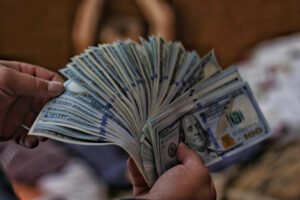




Philippines Trade Update: Exports momentum continues
 DOWNLOAD
DOWNLOAD

Quarterly Economic Growth Release: More BSP cuts to come
 DOWNLOAD
DOWNLOAD

Monthly Economic Update: Fed catches up
 DOWNLOAD
DOWNLOAD


Philippines’ gross dollar reserves dip at end-April

The Philippines’ gross international reserves (GIR) slipped at end-April as the National Government (NG) paid back some of its debt, the central bank said.
Preliminary data from the Bangko Sentral ng Pilipinas (BSP) showed reserves inched down by 0.6% to $103.44 billion as of end-April from $104.07 billion at end-March.
“The month-on-month decrease in the GIR level reflected mainly the NG’s net foreign currency withdrawals from its deposits with the BSP to settle its foreign currency debt obligations and pay for its various expenditures,” the BSP said in a statement late on Tuesday.
Meanwhile, year on year, dollar reserves rose by 1.6% from $101.76 billion.
As of end-April, the level of dollar reserves was enough to cover about 5.9 times the country’s short-term external debt based on original maturity and 3.6 times based on residual maturity.
It was also equivalent to 7.7 months’ worth of imports of goods and payments of services and primary income.
The central bank expects the GIR level to settle at $103 billion by yearend.
Ample foreign exchange buffers protect an economy from market volatility and ensure the country can pay its debts in the event of an economic downturn.
Broken down, the central bank’s foreign investments slipped by 0.06% to $87.89 billion at end-April from $87.94 billion the previous month. Year on year, foreign investments went up by 2.5% from $85.77 billion.
Reserves in the form of gold were valued at $10.26 billion, down by 2.6% from $10.53 billion a month prior, but edging higher by 0.2% from $10.24 billion a year ago.
Meanwhile, foreign currency deposits fell by 26.9% to $791.7 million as of April from $1.08 billion in the previous month. The total was also 30.6% lower than $1.14 billion a year ago.
Net international reserves dipped by 0.6% to $103.4 billion from $104 billion a month earlier. Net international reserves are the difference between the BSP’s reserve assets or GIR and reserve liabilities, such as short-term foreign debt and credit and loans from the International Monetary Fund (IMF).
The country’s reserve position in the IMF inched down by 0.7% to $736.1 million at end-April from $741.3 million a month prior. It also dropped by 9% from $809.3 million year on year.
Special drawing rights, or the amount the country can tap from the IMF, was unchanged at $3.77 billion.
Rizal Commercial Banking Corp. Chief Economist Michael L. Ricafort said the drop in dollar reserves as of end-April was due to “lower foreign exchange holdings amid some foreign debt payments and other expenses by the National Government.”
There was a decrease in the value of gold holdings after world gold prices corrected lower during the month, Mr. Ricafort added.
Union Bank of the Philippines, Inc. Chief Economist Ruben Carlo O. Asuncion said the country’s reserves declined as they were likely used to support the peso, which recently hit 17-month lows against the dollar.
“I would like to think that the reserves were used to defend the peso in April. We know that there has been a lot of pressure on emerging markets currencies since last month,” Mr. Asuncion said in a Viber message.
BSP Governor Eli M. Remolona, Jr. this week said the central bank has only had to intervene in the foreign exchange market in “small amounts” despite the peso’s recent depreciation versus the greenback. — By Luisa Maria Jacinta C. Jocson, Reporter
This article originally appeared on bworldonline.com





 By BusinessWorld
By BusinessWorld